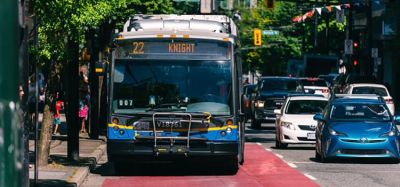Investments to reinforce public transport
- Like
- Digg
- Del
- Tumblr
- VKontakte
- Buffer
- Love This
- Odnoklassniki
- Meneame
- Blogger
- Amazon
- Yahoo Mail
- Gmail
- AOL
- Newsvine
- HackerNews
- Evernote
- MySpace
- Mail.ru
- Viadeo
- Line
- Comments
- Yummly
- SMS
- Viber
- Telegram
- Subscribe
- Skype
- Facebook Messenger
- Kakao
- LiveJournal
- Yammer
- Edgar
- Fintel
- Mix
- Instapaper
- Copy Link
Posted: 22 June 2011 | Göran Gunnarsson, Managing Director and CEO, SL (Stockholm Public Transport) | No comments yet
The Stockholm Region is the largest growth region in Sweden and the population is increasing by almost 30,000 people a year. For all of these people to be able to live, work and travel in the county, an efficient and expansive public transport system equipped to meet current and future demands is essential.
Stockholm is extremely dependent on public transport. Every day, approximately 700,000 people rely on Stockholm Public Transport (SL) to travel in and out of the city centre. During the peak rush hour, almost 80% of all trips to or from the city centre are taken by underground, commuter train, local rail or bus.
The Stockholm Region is the largest growth region in Sweden and the population is increasing by almost 30,000 people a year. For all of these people to be able to live, work and travel in the county, an efficient and expansive public transport system equipped to meet current and future demands is essential. Stockholm is extremely dependent on public transport. Every day, approximately 700,000 people rely on Stockholm Public Transport (SL) to travel in and out of the city centre. During the peak rush hour, almost 80% of all trips to or from the city centre are taken by underground, commuter train, local rail or bus.
The Stockholm Region is the largest growth region in Sweden and the population is increasing by almost 30,000 people a year. For all of these people to be able to live, work and travel in the county, an efficient and expansive public transport system equipped to meet current and future demands is essential.
Stockholm is extremely dependent on public transport. Every day, approximately 700,000 people rely on Stockholm Public Transport (SL) to travel in and out of the city centre. During the peak rush hour, almost 80% of all trips to or from the city centre are taken by underground, commuter train, local rail or bus.
Ongoing investments
A number of major investments are ongoing to reinforce public transport in the Stockholm Region for the future.
Stockholm City Line
The biggest and most complex is the construction of the Stockholm City Line, a 6kmlong rail tunnel for commuter trains, along with two new stations under central Stockholm, which are due to open in 2017.
The project, one of the biggest civil infrastructure projects in Sweden since the Stockholm underground was built in the 1940s and 1950s, will double capacity on the currently overloaded tracks to and from Stockholm Central Station and improve punctuality for Stockholm commuters.
The tunnel project, which is estimated to cost in the region of SEK 17 billion, requires extremely meticulous planning to minimise impact on local residents, businesses and traffic in the inner city. In many places, tunnel construction will pass under listed historical buildings, where extreme care must be observed while the work is performed to prevent damage to the buildings.
Tram City
In parallel, large investments are being made in tramlines in central Stockholm and surrounding suburbs. In the long-term, SL is planning to replace several of the most overloaded bus lines in the inner city with trams. Tram City, the first phase in the expansion of trams in central Stockholm, was inaugurated in 2010. Within a few years, the tram will be the main alternative for people travelling to and from the large new housing areas and commercial districts under development in eastern Stockholm.
The tram is also an efficient mode of transport in adjacent suburbs to Stockholm. An extension of the very popular Cross Line, which connects several main hubs in southern and western Stockholm, is currently under construction. After the expansion, the line, already one of SL’s most popular transport modes, will have approximately 116,000 passenger boardings every day and relieve the underground in the southern parts of the city.
The procurement of the vehicles that will service the new lines was recently concluded. The winning bid was submitted by Spanish manufacturer CAF and covers, including options, a total of 121 vehicles. The new units can be operated in both inner city and suburban service and will be accessible to disabled passengers. Through the contract, SL has secured vehicle supply for several planned expansions of rail traffic in Stockholm County. The first deliveries are planned for spring 2013.
Efficient bus operation
Alongside rail, bus service is a vital component of public transport in Stockholm – every day, about a million trips are taken on SL’s fleet of nearly 2,000 buses, which provide service on everything from short routes in the inner city to county-wide routes on the motorways and major thoroughfares on the outskirts of the Stockholm Region.
In the complex traffic environment of the inner city, it can be difficult at times for buses to get through, which can cause irregular journey times and delays. SL is dealing with the problem by investing in creating more bus lanes and priority signalling for buses at intersections and major service hubs. SL is also studying the Bus Rapid Transit concept for the most overloaded routes in and around the central parts of the city.
Environmental objectives
The city of Stockholm and Stockholm County have very high environmental objectives and public transport plays a crucial environmental role. The more people who leave their cars at home and take public transport instead, the less environmental impact there will be. SL already buys all electricity for rail service from certified renewable sources, such as wind and hydro power.
SL is also a world leader in the use of biogas fuel for bus service. At the end of 2010, there were 131 biogas buses on the roads in central Stockholm and the number is growing all the time. In environmental terms, biogas is currently the best available choice of fuel for SL’s bus fleet. One advantage of the gas is that it is entirely renewable, while helping to link up the natural ecocycle. The locally produced gas is created in only two weeks as bacteria in biogas plants breaks down waste from households, sewer and drain cleaning and agriculture. Switching from fossil-based diesel to biogas reduces carbon emissions from SL buses by about one kg per km driven.
Baltic Biogas Bus project
SL’s biogas programme has garnered keen international interest. Aimed at stimulating the market, technical development and demand for biogas to fuel buses, SL has initiated a three-year international partnership project – Baltic Biogas Bus – financed within the framework of the EU Baltic Sea Region Programme. Twelve organisations and public transport providers from eight countries in the Baltic Sea Region are participating in the project, which began in 2009 and will end in 2012. Exchange of knowledge, lessons learnt and concrete actions are central components of the project, for which SL is the lead partner.
SL’s environmental objectives are very ambitious: by 2025, public transport will be 100% fossil-free. Rail service is already there. Bus service is well on the way. With active environmental management and continued investments in infrastructure, SL is contributing to attaining Stockholm County’s goal of becoming the most attractive growth region in Europe.
About the Author
Göran Gunnarsson has a background in the Swedish armed forces, where he has held a variety of positions, most notable as Chief Military Observer UNMOP, (Balkan), and Manager for the Main Operation Management at the High quarter. He retired at the rank of Lieutenant General. Between 2006 and 2008, he held office as General Director for the Swedish Rescue Services Agency. Since 1 October 2009 until present, he is the Managing Director and CEO at Storstockholms Lokaltrafik (SL). Other notable assignments includes Chairman for the National Association for Road Safety, Board member of the Royal Naval Society and Board member of the Swedish War Science Academy.
Related topics
Business Models, Fleet Management & Maintenance, Public Transport
Issue
Issue 3 2011
Related cities
Sweden
Related organisations
AB Storstockholms Lokaltrafik (SL), SL
Related people
Göran Gunnarsson








